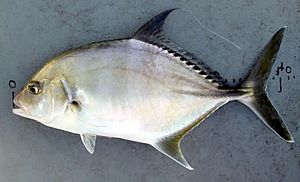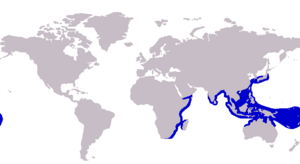Coachwhip trevally facts for kids
Quick facts for kids Coachwhip trevally |
|
|---|---|
 |
|
| Conservation status | |
| Scientific classification | |
 |
|
| Approximate range of the coachwhip trevally | |
| Synonyms | |
|
The coachwhip trevally (Carangoides oblongus) is a cool fish that lives in the ocean. It's also known as the oblong trevally or oblique-banded trevally. This fish belongs to the jack family, called Carangidae.
You can find the coachwhip trevally in the Indo-west Pacific region. This huge area stretches from South Africa all the way to Fiji and Japan. It's a medium-sized fish, growing up to about 46 cm long. Scientists can tell it apart from other similar fish by looking closely at its teeth, fins, and scales.
This fish loves to live in coastal waters, especially in estuaries. Estuaries are places where rivers meet the sea. We don't know much about what it eats or how it has babies. It's not a big target for fishermen, but sometimes it gets caught by accident in nets or on fishing lines.
Contents
What's in a Name? The Coachwhip Trevally's Story
The coachwhip trevally is part of a group of fish called Carangoides. These are often called jacks or trevallies. All these fish belong to the larger jack and horse mackerel family, Carangidae. This family is part of an even bigger group called Carangiformes.
A French scientist named Georges Cuvier first described this fish in 1833. He found a specimen (a sample fish) near New Guinea. Cuvier named it Caranx oblongus. The word "oblongus" means 'oblong' in Latin, which describes the fish's shape.
Over time, scientists moved this fish into different groups. Finally, it found its home in the Carangoides group, where it still is today. Other scientists also described this fish later, giving it different names like Caranx auriga or Caranx tanakai. But since Cuvier described it first, his name is the official one. The name 'coachwhip trevally' comes from its long, whip-like fin on its back.
How to Spot a Coachwhip Trevally: Its Look
The coachwhip trevally is a medium-sized fish. It can grow up to 46 cm long, which is about the length of your forearm! It looks a lot like other fish in its family, especially the shadow trevally. It even has a similar "shadow" look under its second back fin.
This fish has a body that's a bit flat and long, like an oblong shape. Its back is more curved than its belly. The head also has a slight curve.
Its back fin is split into two parts. The first part has 8 stiff spines. The second part has 1 spine and 20 to 22 soft rays. This second part is long and whip-like, even longer than the fish's head! Its bottom fin has 2 spines at the front, then 1 spine and 18 or 19 soft rays. The fins on its belly have 1 spine and 18 or 19 soft rays.
The lateral line on its side (a special line of scales that helps fish sense vibrations) has a curve at the front. This curved part has 60 to 69 scales. The straight part has 0 to 2 scales and 37 to 42 scutes (which are like tough, bony plates).
The fish's chest area doesn't have scales. Its jaws have many small teeth. The teeth at the front are wider. Bigger fish might even have larger outer teeth on their lower jaw. It has 26 to 30 gill rakers (which help it filter food) and 24 backbones.
The coachwhip trevally is a dark olive green on top. This color fades to a shiny silver or yellow on its belly. It often has small blue or black spots along its back, near its second dorsal fin. Its upper tail fin and soft dorsal fin are a dusky blue. The anal fin is yellow with white tips. Its belly and side fins are yellow. Sometimes, it has a faint dark spot near its gill cover, but this can be hard to see.
Where Do Coachwhip Trevallies Live?
You can find the coachwhip trevally in the tropical and subtropical parts of the Indian Ocean and the western Pacific Ocean.
In the Indian Ocean, it lives from South Africa and Madagascar up to the Gulf of Aden. However, it's not found in the Red Sea. You can find it further north near India and Sri Lanka. In the eastern Indian Ocean, it lives near China, Southeast Asia, Indonesia, and northern Australia.
In the Pacific Ocean, its home stretches from Papua New Guinea north to Taiwan and Japan. It also lives east towards New Caledonia and Fiji.
This fish loves to live in coastal waters. Young coachwhip trevallies are often found in estuaries. These are places where fresh river water mixes with salty ocean water. Scientists have seen them in estuaries around Australia, Fiji, and the Solomon Islands. Adult fish also live in estuaries, but they might move into bays and over shallow reefs as they get older.
Life and Fishing for the Coachwhip Trevally
We don't know much about the coachwhip trevally's daily life. Scientists haven't collected much information about what it eats, how it interacts with other animals, or how it grows and reproduces.
However, since it's related to other fish in its genus, we can guess it's a predator. This means it hunts and eats other smaller creatures. But exactly what it eats is still a mystery!
The coachwhip trevally is not a very important fish for fishermen. They don't usually try to catch it on purpose. When it is caught, it's usually by accident. This happens when fishermen are trawling (dragging large nets) or using hook and line to catch other types of fish. So, you won't find specific numbers on how many coachwhip trevallies are caught each year. They are usually just counted along with other trevally species.
See also
 In Spanish: Carangoides oblongus para niños
In Spanish: Carangoides oblongus para niños


